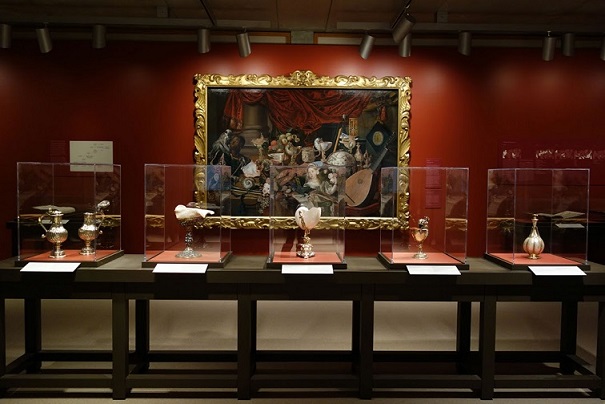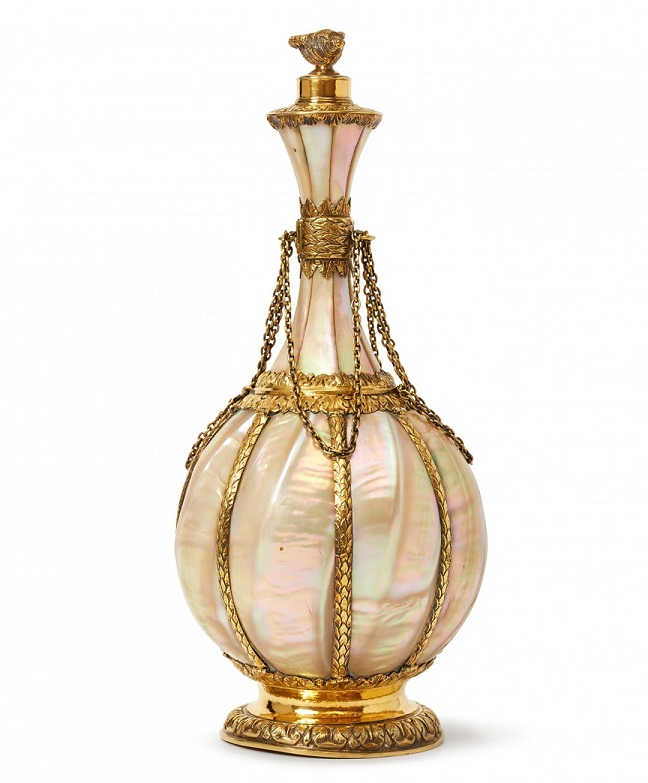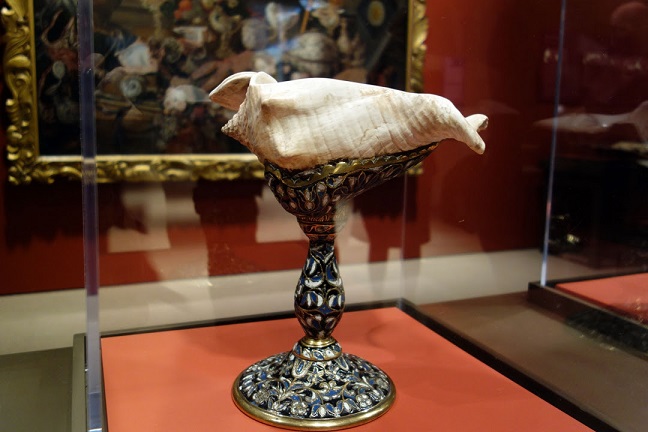
Installation view of The Paston Treasure: Microcosm of the Known World (photo by the author for Hyperallergic)
Although the painting is called “The Paston Treasure,” it depicts only the highlights from the hundreds of souvenirs at Oxnead Hall. Each has exacting true-to-life detail, a resemblance that can be verified by comparing the painted treasures to their extant counterparts. A sea monster-shaped nautilus cup is now at the Museum Het Prinsenhof in Delft, a nautilus cup with a base of silver sea nymphs is at the Rijksmuseum in Amsterdam, and a pair of silver flagons are at the Metropolitan Museum of Art in New York.
For the first time in over three centuries, five of the pictured objects have been reunited with the painting in the Yale British Art Center’s The Paston Treasure: Microcosm of the Known World. This is also the first time “The Paston Treasure” painting has traveled to North America. The sprawling exhibition of almost 140 objects (including those with Paston connections and those that are contextual) is on view in New Haven through May 27, and will subsequently open on June 23 at the painting’s permanent home, the Norwich Castle Museum and Art Gallery in Norfolk.
Installation view of The Paston Treasure: Microcosm of the Known World (photo by the author for Hyperallergic)
The artist of “The Paston Treasure” is thought to be a Dutch itinerant painter. The only other known work attributed to the same artist is an oil on canvas painting from the 1660s that features the exact same African grey parrot that appears in “The Paston Treasure.” Like most still-life artists, he likely recycled imagery in his commissions. It’s unclear, also, whether the artist was commissioned by the traveling Sir William Paston, or by his oldest son, Robert. Robert likely oversaw its completion following his father’s death in 1663, which could explain changes that were made when the painting was almost finished. A recent X-ray analysis revealed a silver platter that was replaced by a woman, who was later covered with a looming black diamond-shaped timepiece. After William’s death, his will dictated that his possessions be divided between Margaret and Robert, leading to some tension over who would get what (perhaps including the silver platter). It’s possible that the woman was Margaret, or an allegorical figure to replace the silver platter. However, it could also be that the clock was chosen as a symbol of the passage of time, and that the painting memorialized the death of William.
Unknown artists (Gujarati and English), Mother-of-Pearl Flask (first half of the 17th century), with mounts (1650–60), mother-of-pearl from the Turbo marmoratus (assembled in Gujarat), silver gilt (mounted in London) (private collection, London, photo by Jon Stokes)
At the far left of “The Paston Treasure” a young black man arranges the sea creature shell vessels on a cluttered table. He may have been a servant or slave of the Pastons, or another person brought to England through the transatlantic slave trade that was then part of the country’s economy. The painter presents him as an object of wonder: his dress is theatrical, with billowing sleeves of green velvet, and perched on his shoulder is a monkey. The emerging globalism and colonial expansion that facilitated William Paston’s travel and collecting are also the reason that this figure is here, and he was likely painted from life as his expression and pose are so detailed. Draped with sumptuous fabric, he is being transformed like one of the sea creature vessels with their gilt ornamentation, and with as little consideration for his individual experience.
In contrast, the only other human is a white girl who sits across the table in a green chair and holds a small bouquet of roses in one hand, a book of music in the other (on which the parrot perches). Whereas he is the most active presence in the painting through his gestural movement, she looks off into the distance away from the chaotic accumulation. It’s believed she is Robert’s oldest child Margaret, and that her image was copied from another portrait, lighting and all. That could be why she looks so different from the rest of the painting, like she emerged from some portal, but it also sets her apart as not being one of these amassed objects of imperialism. Her sickly pallor, however, is due to the deterioration of the pigments, which were made from buckthorn plant berries and insects, both light-sensitive and subject to fading.
Installation view of The Paston Treasure: Microcosm of the Known World (photo by the author for Hyperallergic)
The abundance of red in “The Paston Treasure” — some of which has faded — may be linked to 17th-century alchemical searches for the “red elixir,” a type of Philosopher’s Stone, a legendary substance for transmuting base metals into gold. Robert Paston had a proclivity for alchemy. While his father collected foreign mementos, Robert avidly collected alchemical books and tested their recipes. Like so many before him, however, he failed to find the right recipe for gold.
Robert’s alchemical investigations likely influenced the diversity of pigments in “The Paston Treasure.” The painting was made with a lavish and apparently arbitrary array of rare pigments, including four types of blue, among them the pricey lapis lazuli made from semi-precious stones. It also includes verdigris green, the result of exposing copper to organic acid vapors, and the blue smalt from cobalt glass. His 1659–83 book of alchemical, home remedy, and even cooking (such as his mother-in-laws “Nourishing Broth”) recipes, recently acquired by Yale’s Beinecke Rare Book and Manuscript Library, has concoctions for “colors for oyles” alongside his experiments on the Midas touch.
Besides the mystery of the painting’s creation, there are many enigmatic details in the work itself. If it was commissioned to celebrate wealth and this collection, why is haunted by symbols of the fleetingness of material gain? Lurking among the imagery are snuffed out candles, soon-to-spoil fruits, a sand-glass, and ticking clocks. The young girl holds a fully bloomed rose in one hand, and in the other a score for “Charon, O Charon heare a wretch opprest,” a song from the perspective of a dead person asking for passage over the River Styx.
Installation view of The Paston Treasure: Microcosm of the Known World (photo by the author for Hyperallergic)

Installation view of The Paston Treasure: Microcosm of the Known World (photo by the author for Hyperallergic)
In the catalogue that accompanies the exhibit, Andrew Moore, former keeper of art at Norwich Castle Museum & Art Gallery, writes: “If William Paston commissioned the painting, he was thinking about his death and the collection’s fate. If his son Robert commissioned it, the work is about the passage of goods from one generation to another, and perhaps a celebration of the family’s ability to keep the collection together as much as a tribute to his father’s passing.” This latter theory may account for the ominous symbols that remind the viewer that time is running out and material joys will not last.
A poem by an unidentified author dedicated after William’s death reads: “There is lacking in his treasure-house this one unique and everlasting gem: it is called eternal life. To purchase this, he sails under Christ’s auspices, to the market of the new Jerusalem.” In amassing the series of rare objects that comprised his collection, William sought to achieve immortality. The Paston Collection was one of many European private collections, or kunstkammer. In each, almost anything deemed “exotic” was prized — be it coconuts or a complicated clock. Later these cabinets of curiosities became foundational collections in public museums. In Ways of Seeing, John Berger offers an image of “The Paston Treasure” as an example of how collectors attempted to “possess” as a way of seeing — an audacity for ownership that was taken on by museums.
The Pastons never founded a museum, or donated their collection as a whole. Although “The Paston Treasure” painting was, as the exhibition title states, intended as a “microcosm of the known world,” its legacy is as a visual record of a lost collection, or at least its highlight reel. The circular path of the exhibition at the Yale British Art Center leaves visitors where they started, witnessing the hulking painting and the reassembly of the surviving treasures. The idea of being able to create an encyclopedic representation of the world still endures in museums, even if few visitors are likely to come today to marvel at the nautilus cups. Returning to the painting, and the five vessels that rejoin it at the Yale British Art Center, it’s possible to read another meaning on the objects: just as the invertebrates that once lived in these shells have passed, so too must all things.
Installation view of The Paston Treasure: Microcosm of the Known World (photo by the author for Hyperallergic)









